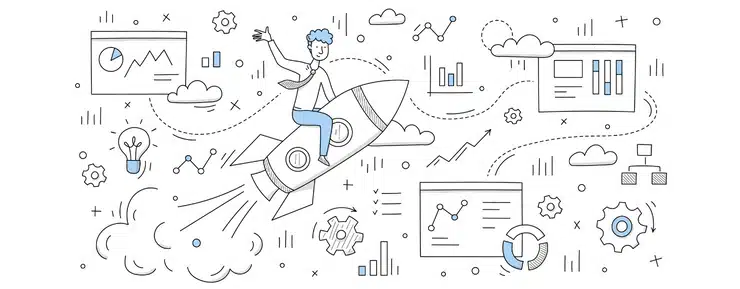What Is Data Collection? Methods, Types, Tools, and Techniques

Introduction
The primary goal of data collection is to gather high-quality information that aims to provide responses to all of the open-ended questions. Businesses and management can obtain high-quality information by collecting data that is necessary for making educated decisions.
It is necessary to gather data to draw conclusions and decide what is factual to increase the quality of the information.
By the time you’re finished reading this, you’ll know why choosing the appropriate data collection strategy is essential for attaining your specified goal.
What is Data Collection? A Definition
Data collection is gathering and analyzing information on relevant variables in a predetermined, systematic way so one can respond to stated research questions, test theories, and assess results.
In statistics, data collection is the process of obtaining information from all relevant sources in order to solve a research topic. It aids in determining the outcome of the situation. The data collection methods enable a person to get a conclusion on the relevant subject. The majority of firms employ data collection techniques to predict probability and trends in the future. After the data has been gathered, the process of organizing the data must be done.
Although methods and objectives may differ depending on the field, the core data collection approaches are essentially the same. In other words, certain standards must be strictly adhered to ensure that data is gathered accurately.
Therefore, you must reconsider and examine each of your study aims before you begin collecting data. Make a list of all of your goals to start. Here are some crucial inquiries to think about:
- What is the objective of your study?
- What kind of data are you collecting?
- How will you obtain, store, and process the data you’ve gathered?
- What data collection techniques and procedures will you employ?
Why Do We Need Data Collection?
Collecting evidence is the goal of proper data collection so that analysis can be done. This analysis establishes genuine and reliable discoveries as responses to trends, probability, and study. It is essential for preserving the integrity of the research.
Errors can be decreased via accurate data gathering and its techniques. Since gathering data is essential regardless of the study subject, it is the most crucial part of the process. The collection of inaccurate data can result in a variety of problems, such as the following:
- If the data is inaccurately acquired, you will be unable to find accurate answers to your questions.
- Incorrect responses will produce erroneous results, which will involve further data collection and investigation.
- If these false findings are made public, they may have problems when used. One such instance involves flawed medical research that may endanger human life.
- Businesses will occasionally make poor choices that result in losses.
What Are the Different Methods of Data Collection?
Data collection techniques are very important and necessary as we have different types of data from where the right information and the correct implications need to be extracted. Primary data and secondary data are the two categories into which data can be divided. Data collection is crucial to any study or business activity because it makes it possible to identify a number of crucial aspects of the firm, including performance. As a result, the data collection procedure is crucial in all streams. The two categories of data collection methods are separated according to the type of data being collected:
Primary Data Collection Methods
What is primary data? Primary data is also referred to as first-party data when it comes to the information that companies gather about their clients. The information you obtain directly from your audience is known as first-party data. Your customer relationship management system’s data, the information you collected from internet sources, or offline information you obtained from clients through surveys and other sources could all be included.
It could be further broken down into two categories: quantitative data collection techniques and qualitative research techniques.
Qualitative Research Method: The qualitative research methods of data collection is based on non-quantifiable factors such as the feeling or emotions of the researcher and do not entail the collection of data that involves numbers or a need to be derived through a quantitative calculation. An open-ended questionnaire is a prime illustration of such a technique.
Quantitative Methods: Quantitative approaches convey information as numbers that must be derived through mathematical calculations. An illustration would be the usage of a survey using closed-ended questions to get mathematically calculable numbers. Moreover, regression and correlation techniques, as well as mean, mode, and median.
Secondary Data Collection Methods
Secondary data refers to information collected by someone other than the researcher. Public data is easily accessible and does not require specialized data collection techniques. Data can be gathered from other sources as well as directly from the business or organization conducting the research. Company records, financial statements, yearly reports, employee data, reports obtained from clients, and dealer reports are some of the internal sources used to acquire secondary data. Information obtained from books, journals, magazines, official census data, information found on the internet regarding the research topic, and other sources are examples of secondary data from outside sources. The key benefit of this data collection approach is that it is easy to gather since it is easily accessible.
What Are Data Collection Tools?
The term “data collection tools” refers to the tools/devices used to collect data, such as a paper questionnaire or a system for computer-assisted interviews. It is crucial to choose the tools for data collection because research is conducted in various methods and for various goals. Some common data collection types are given below:
Word Association: Word association has been used to identify the meaning of icons for graphical user interfaces by gathering data on people’s perceptions, emotional states, mental models, and language.
Sentence Completion: Researchers use sentence completion to identify the respondent’s ideas. With this data collection technique, you give the interviewee an incomplete statement and see how they fill it.
Role-Playing: Respondents are given a hypothetical circumstance and have to respond to that.
In-person Surveys: A person will ask face-to-face questions.
Online/Web Surveys: These surveys are simple to complete, but people are not comfortable with the virtual world.
Mobile Surveys: These surveys benefit from the growing use of mobile technologies. Mobile devices like tablets or smartphones are required for mobile collection surveys that use SMS or mobile apps.
Phone Surveys: A third-party app is required to call thousands of people at once, and call filtering prevents many individuals from answering the phone.
Observation: The simplest solution is effective in some cases. Direct observational researchers get data fast and readily, with little interference or outside bias.
The Need to Ensure the Collection of Accurate and Appropriate Data
You must adhere to the steps listed below for accurate data collection once the data collection process has begun.
- You must understand the motivation for your study before you begin the data collection procedure. You should be aware of the queries this research needs to address. The issue for which you need to collect data should be identified as one of the relevant approaches for this purpose.
- After determining the goal of the data collection, you must pick a suitable data collection technique. Select a strategy that seems appropriate for resolving your query. You must choose the appropriate study focus group for this reason.
Challenges in Maintaining Data Integrity
Data integrity issues can be aggravating, such as when they result in a brief loss of access to a data set. They can also have disastrous results, such as when there is a breach, all of your customers’ Personal Identifiable Information could be lost or, worst used for immoral purposes. Failing to handle data integrity issues can have expensive, lasting effects in terms of lost productivity and money, missed opportunities, and reputational harm.
Quality assurance and quality control are two measures that help safeguard data integrity and ensure the veracity of study findings in the research world.
Quality Assurance
The main objective of data collection is “prevention,” as it comes before quality assurance. This is the greatest strategy to safeguard the accuracy of data collection. The best illustration of this proactive measure is the protocol standardization established in the comprehensive and detailed procedures manual for data collection.
Quality Control
Although quality control measures (detection/monitoring and intervention) occur both after and during data collection, the details should be thoroughly specified in the procedures manual.
Common Challenges in Data Collection
The following are some of the challenges frequently encountered when collecting data:
Data Quality Issues: Raw data contains numerous mistakes, discrepancies, and other problems. Ideal data collection practices are utilized to avoid or reduce such issues. Acquired data is typically subjected to data profiling to detect and correct problems.
Inconsistent Data: Various files contain diverse information about the same object or person. As a result, there can be inaccurate and meaningless information. Data redundancy is the main cause of inconsistent data.
Data Downtime: Data-driven organizations base their decisions and operations mostly on data. However, there can be a few instances where their data is inaccurate or incomplete.
Ambiguous Data: Unnoticed spelling errors, formatting issues, and false column headings can all arise. Reporting and analytics may experience a number of issues as a result of this ambiguous data.
Duplicate Data: The sources of data that modern organizations must manage include local databases, cloud data lakes, and streaming data. They might also have silos for their systems and applications. These sources are quite likely to overlap and replicate one another.
Too Much Data: Although we highlight data-driven analytics and its benefits, there is a problem with abundant data that affect data quality. It can get overwhelming when looking for data relevant to your analytical efforts.
Inaccurate Data: Data input errors are the result of bad data entering procedures.
Hidden Data: Every sort of data in a file that is concealed while using a conventional viewer is referred to as hidden data in a file. Nonetheless, hidden data may be read by altering the viewer’s settings or using specialized software to disclose the hidden data.
Finding Relevant Data: For data scientists and other users in an organization, acquiring data to analyze can be a formidable task due to the variety of systems they must navigate. Utilizing data curation strategies makes it simpler to locate and retrieve data.
Deciding the Data to Collect: Unnecessary data collection increases process time, expense, and complexity. A data set’s commercial value can be constrained, and analytics outcomes can be impacted by leaving out useful data.
Dealing with Big Data: Large volumes of structured, unstructured, and semi-structured data are frequently present in big data contexts. Because of this, the earliest stages of data collecting and processing are more difficult.
Low Response and Other Research Issues: Lack of responses or active participants in research investigations calls into question the reliability of the information gathered.
Conclusion
Data gathering has evolved into a vital corporate and professional approach. Understanding its procedures can help academics and business owners collect data in the most precise way, even though it may be challenging work for them. If you’re interested in getting a relevant certification, UNext Jigsaw’s Integrated Program in Business Analytics is highly recommended.



















